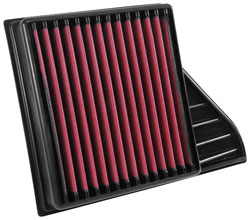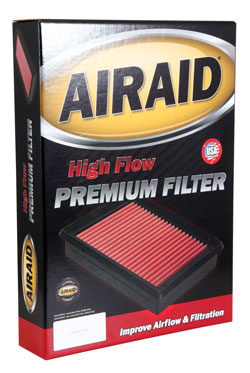AIRAID Air Filter for 2010-2014 Ford Mustang Offers High Airflow and Great Filtration
- Feb 3, 2017
Two engines were available to power the 1965 Mustang –- a 200-cubic inch six-cylinder that delivered 120-horsepower and a 289-cubic inch V8 that generated 210-horsepower and was offered in hardtop, fastback, and convertible body styles. From 1967 until 1973 the Mustang got bigger, but not necessarily more powerful. It physically became more massive, which permitted the use of a big block engine for the first time. In its second generation starting in 1974 and lasting until 1978, Lee Iacocca, the driving force behind the creation of the original Mustang and who by this time was President of Ford, demanded that the car be made smaller and more fuel efficient. When the second-generation model was finally released, it was the same size, shape and had the same overall style as the original 1964 model. In order for it to meet new U.S. Government emission and safety regulations its performance capability was reduced. Two engines were available to power the 1974 model –- a 2.3-liter I-4 that was used on the Ford Pinto and a 2.8-liter Cologne V6 that also powered the Mercury Capri. A 302-cubic inch Windsor V8, which had been used to power a version of the first generation Mustang, was re-introduced in the 1975 model year with the C-4 automatic transmission, power brakes, and power steering. It was available in coupe and hatchback and there was also a Ghia Model, the so-called “luxury” variants, that was designed by Ghia of Italy, which had recently been acquired by Ford. The third-generation Mustang was introduced in 1979. It was based on the platform that was originally developed for the 1978 Ford Fairmont and Mercury Zephyr. Despite a smaller rear seat, the car could accommodate four people. Body styles included a coupe, notchback, hatchback, and convertible. Trim levels included L. GL, GLX, LX, GT, GTS, Turbo GT, GT-350, SVO, Cobra, Cobra R, and Ghia. The engines that powered the third-generation models included electronic fuel injection rather than a carburetor. The fourth generation Mustang was unveiled in 1994 and it was the result of the first major redesign in 15 years.
The 1999 model featured a 3.8-liter V6 with a new split-port induction system was the standard engine and delivered 190 bhp. A 3.9-liter variant of the Essex engine replaced the 3.8-liter V6 in 2004. Models that were available during the fourth generation included the Bullitt, Mach 1 and the Cobra, the first Mustang to feature an independent rear suspension. The fifth-generation Mustangs were manufactured from 2005 through 2014. A cast-iron block 4.0-liter SOHC V6, which generated 210-horsepower, powered the cars from 2005 to 2010. Mustangs released in 2010 and beyond featured a new 3.72-liter (227-cubic inch) aluminum block V6 engine that produced 305-horsepower and 280 lb-ft (380 N-m) of torque. GT models featured a 32-volve 5.0-liter (302.13-cubic inch) engine known as the Coyote that produced 412-horsepower and 390 lb-ft of torque. A 5.4-liter supercharged V8 aluminum block V8 that offered 550-horsepower and 510 lb-ft (690N-m) of torque powered the GT500. In 2012 a new Mustang Boss 302 model was introduced with an engine that delivered 444-horsepower and 380 lb-ft (520 N-m) of torque. An upgrade of the fifth-generation Mustang was introduced in the second quarter of 2012. The Shelby GT500 featured a new 5.8-liter supercharged V8 that produced 662-horsepower. Shelby and Boss engines included a 6-speed manual transmission. AIRAID is offering the 851-500 replacement air filter for 2010-2014 Ford Mustangs. The drop-in filter features a multiple layered dry filter media and is designed to replace the factory paper air filter. Engineered to deliver higher airflow with less restriction, the filter is washable and reusable and backed with a Lifetime Guarantee as well as a No Hassle Warranty. The AIRAID 851-500 Replacement Air Filter is designed for the following vehicle applications. 2014 FORD MUSTANG GT 5.0L V8 Fuel Injection - All Models | |||
| | |||
| | |||
| |||
| | |||










